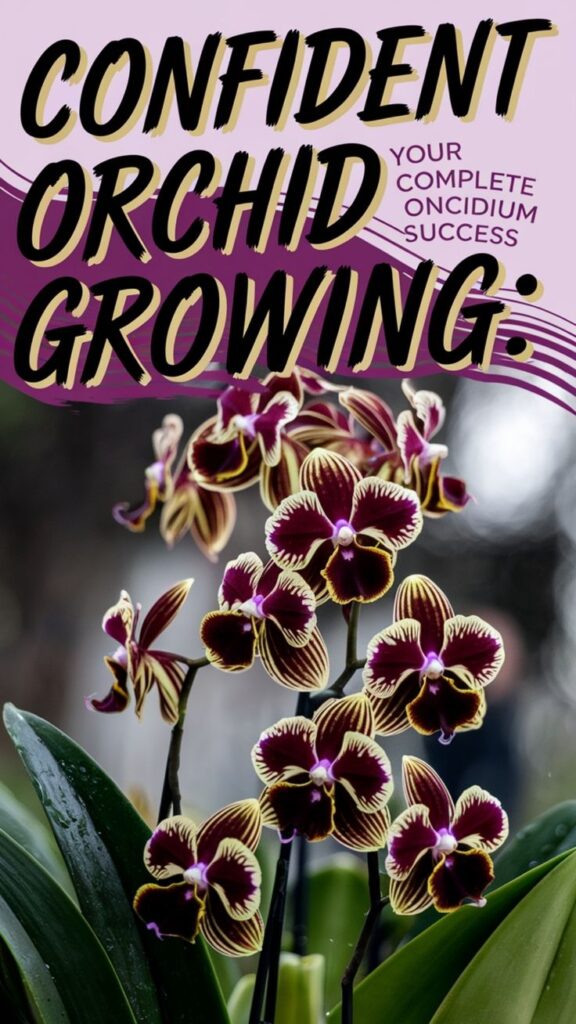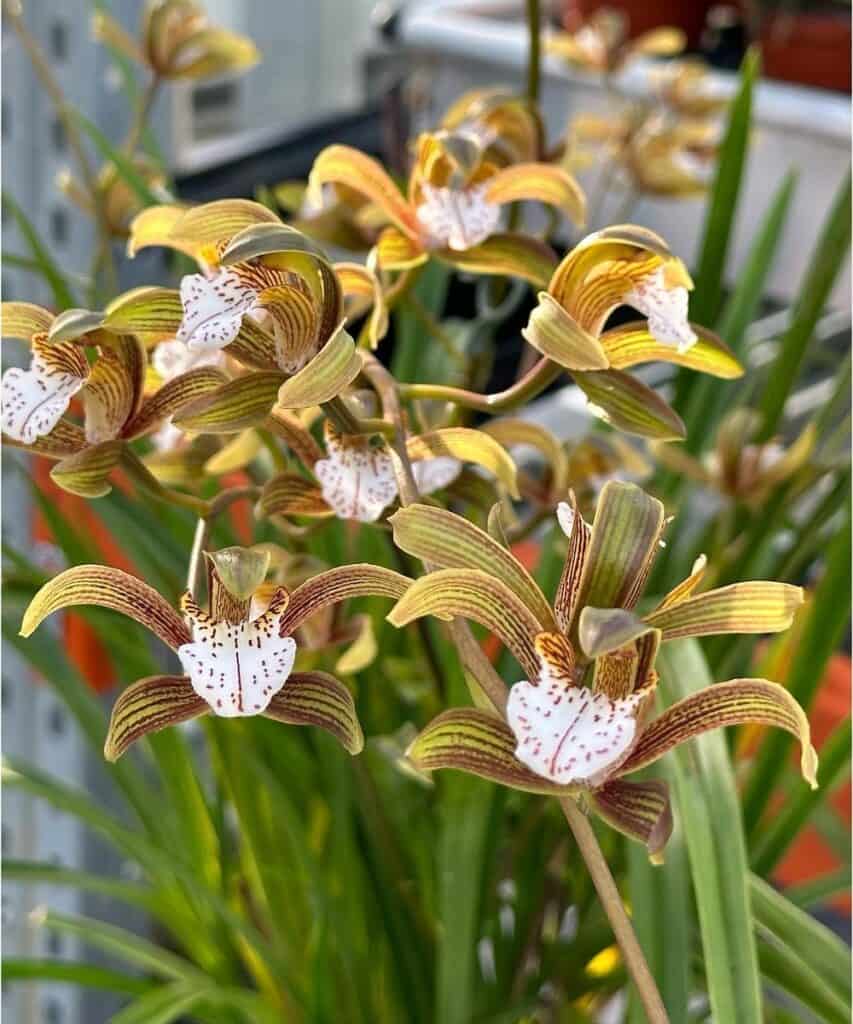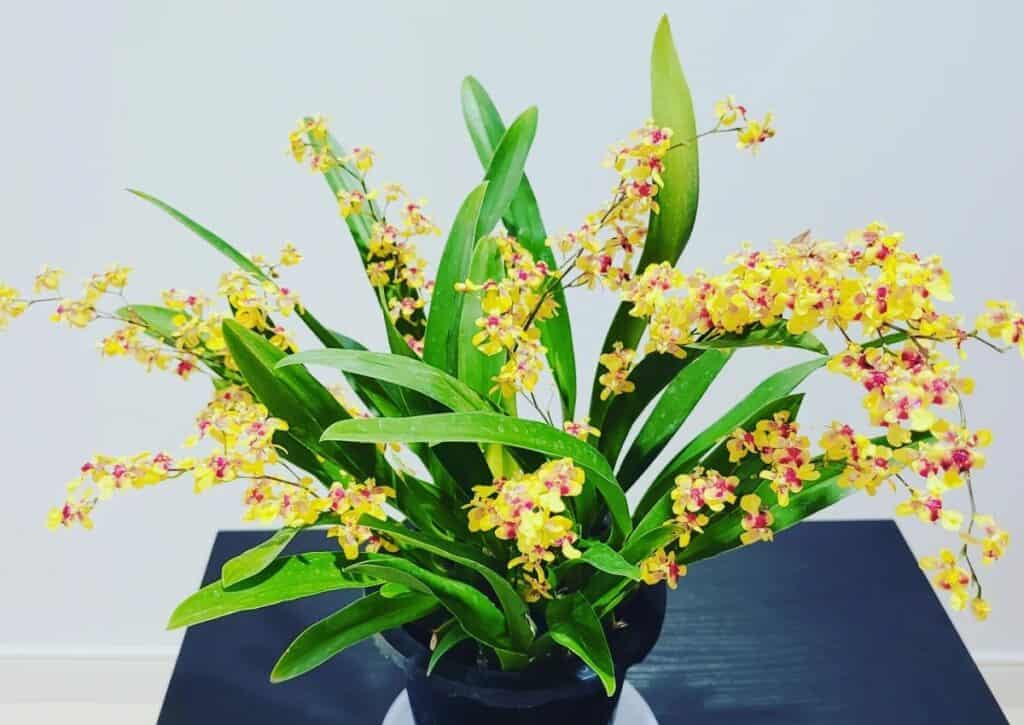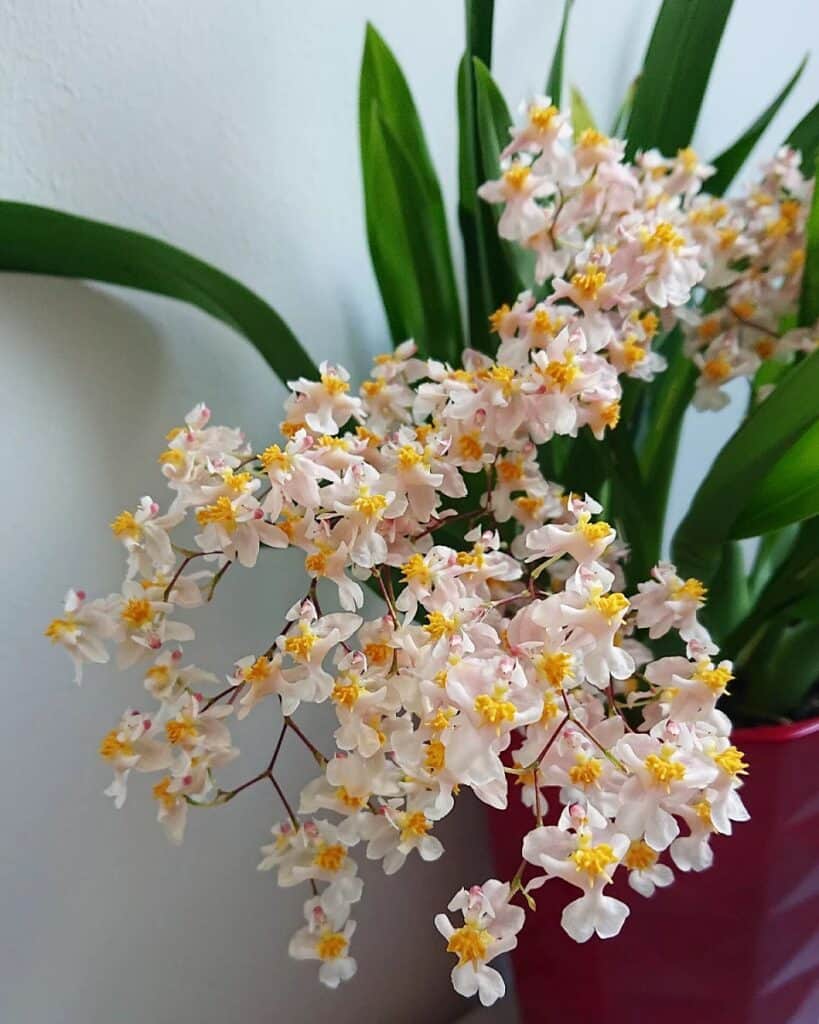Oncidiums, also known as “dancing ladies” is one of the most beautiful orchids out there. With their bright yellow and red petals, these gorgeous flowers can bring a touch of beauty to any home. But before you take on an Oncidium Orchid for yourself, it’s important that you learn how to properly care for it. This article will provide you with all the essential information you need to keep your Oncidium happy and healthy!

If you’re looking to add some life and color to your living space, then investing in an Oncidium orchid is definitely worth considering. These stunning plants not only look amazing but they’re also surprisingly easy to maintain – so long as you familiarize yourself with the basics first.
Whether this is your first time caring for an orchid or if you’re simply looking for tips on keeping yours alive longer, our comprehensive guide on Oncidium orchid care has got you covered! We’ll go over everything from light requirements and watering schedules to repotting techniques and much more – providing all the details necessary for creating a safe environment for your plant!
Contents
- 1 Types Of Oncidium Orchids
- 2 Light Requirements For Oncidium Orchids
- 3 Watering And Fertilizing Oncidium Orchids
- 4 Soil And Potting Requirements
- 5 Temperature And Humidity Considerations
- 6 Pruning And Propagating Oncidium Orchids
- 7 Growing Oncidium Orchids From Seed
- 8 Overwintering Oncidium Orchids
- 9 Common Pests And Plant Diseases
- 10 How To Get Oncidium Orchids To Bloom
- 11 Common Problems With Oncidium Orchids
- 12 Conclusion
Types Of Oncidium Orchids
Oncidium orchids, with their sheer curtain of petals and vibrant colors, are one of nature’s most beautiful blooms. From the small twinkle-eyed varieties to large sprays of dancing yellow blossoms, there is an Oncidium for everyone. But what types of Oncidiums can you find? The classic type of this orchid species have long thin stems that produce a spray of flowers in varying shades like red, orange, yellow and white. Some have even been known to be scented!
Then there is the oncidium ‘Sharry Baby’, which has dark red petals edged with bright yellow – truly stunning. The mini-oncs come in all sorts of shapes and sizes making them ideal for small spaces. And if you’re looking for something different then why not try the butterfly Oncidiums? These spectacular beauties look just like a butterfly when they bloom!
All these types need lots of light from south-facing windows but should also be protected from direct sunlight so it pays to read up on your particular variety before buying one. Most importantly though make sure you follow the instructions provided on each Oncidium culture sheet as this will help ensure your plant thrives!
Light Requirements For Oncidium Orchids
Oncidiums prefer bright indirect light throughout the day in order to flourish. To ensure that they have sufficient lighting, place them near west-facing windows that receive several hours of direct sunlight while avoiding exposure during the hottest times of the day.
It’s also best to protect your plant from strong winds which could cause damage. If you don’t have access to natural lighting, artificial lighting can be used but make sure it is not too close as this may cause burning on the leaves.

Watering And Fertilizing Oncidium Orchids
When caring for your orchid, humidity levels are incredibly important – too much water and there could be dire consequences, while too little will cause them to wilt away. Ideally, you want to keep your orchid moist without overwatering. Water requirements vary depending on factors such as weather conditions, temperature and even how quickly the potting mix dries out.
Non-softened water is best since softeners contain salts which can damage roots over time. A good rule of thumb is to water once every 7-10 days during spring and summer months and reduce watering frequency during winter months when growth slows down significantly.
Fertilizers should be used sparingly yet regularly at about one-quarter strength compared to what is recommended in the package instructions. Check frequently that your plants have sufficient fertilizer by looking for healthy new growths from the base of the plant. Apply fertilizer only when needed as too much may burn their delicate leaves and flowers!
Soil And Potting Requirements
The ideal growing medium for an oncidium orchid should be bark-based with fine-grade potting media added in. This combination gives the plant enough drainage and aeration while still providing ample water retention when required. Additionally, this porous medium helps maintain humidity levels that are beneficial to the health of the plant. It’s important to keep in mind not to use regular potting mix as it may contain fertilizers that could damage your orchid’s roots over time if used continuously.
To ensure you’re successful in caring for your oncidium orchid, make sure you provide adequate drainage by using tools like a clay pot with holes at the bottom and always repot every couple of years into fresh bark-based growing medium mixed with fine-grade potting media so your flower stays healthy and happy!

Temperature And Humidity Considerations
For starters, ensure that there is good airflow around your orchid’s pot – this helps keep both soil moisture and ambient air from becoming stale. Additionally, you should look into local atmospheric humidity levels; as a rule of thumb, aim for a relative humidity level between 50% and 60%. Finally, make sure that nighttime temperatures do not drop below 65°F (18°C). Doing so will help promote optimal growth while keeping your plant healthy!
When selecting a location to place your orchid, remember that too much heat can be just as damaging as cold. Take all of these considerations into account when deciding where to put your beloved flower – with the right conditions in place it will surely thrive.
Pruning And Propagating Oncidium Orchids
To begin pruning your oncidium orchid, start by discarding any discolored leaves. This will help to ensure that the plant remains healthy and strong. After removing dead foliage, you’ll want to trim off any overgrown roots while keeping an eye out for signs of rot or decay in the medium. Make sure it’s well drained so the roots have room to breathe. When cutting back stems, take care not to damage emerging buds. It’s also important to keep track of where you made each cut because this will determine which way the new shoots grow when they emerge again later on.
You may also choose to propagate your oncidium orchid if you’d like more than one specimen growing in your home. To do so, carefully remove a few healthy shoots from the parent plant and replant them into fresh soil with plenty of drainage holes at the bottom of a potting container. Water regularly and provide ample light until new growth appears and then treat it just as you would its mother plant!
Growing Oncidium Orchids From Seed
Growing Oncidium Orchids from seed can be a rewarding experience, but it’s important to understand the right conditions needed for successful germination. Make sure you use a medium-grade potting mix that provides good drainage and ensures adequate root growth. This is key to helping your orchid thrive!
Once you’ve chosen the perfect soil, keep your plant moist until the roots begin to grow; this usually takes around 4-6 weeks. Remember, too much water can stunt the development of the roots – make sure not to overwater! It’s also beneficial to provide extra humidity during this stage. Once your little sprout has taken off, gradually reduce the watering frequency as your orchid matures into adulthood.
Taking care of an Oncidium Orchid from seed requires patience and attention – but with some TLC and regular maintenance, you’ll have a beautiful bloom before long!
Overwintering Oncidium Orchids
It’s true that overwintering oncidium orchids can be a tricky process, but with the right knowledge and preparation, you can ensure your beloved plant is kept safe during the winter months. In this guide, we’ll explore how to successfully overwinter an oncidium orchid so it will thrive in years to come.
First things first: when it comes to finding the perfect spot for your orchid, east or west-facing windows are best as they provide more even lighting conditions than south-facing windows do. You should also make sure that temperatures don’t drop below 50 degrees at night – if necessary, look into buying some extra insulation such as thick curtains, or moving your plants indoors overnight. Avoid over-watering too – let the potting medium dry out completely before rehydrating again.
The type of potting medium you use is also important; while most people prefer bark mixes, sphagnum moss mixed with perlite and charcoal works well too. Whichever mix you choose, make sure you monitor moisture levels closely throughout the winter season and adjust accordingly depending on temperature fluctuations and humidity levels in your home. With patience and diligence, there’s no reason why your oncidium won’t survive through winter!
Common Pests And Plant Diseases
Have you ever noticed that orchids are particularly prone to pests and diseases? It may seem like an unfair burden for such a delicate plant, but there is some truth in this theory. To ensure your oncidium orchid care guide includes dealing with common pests and plant diseases, it’s important to be aware of the signs.
The most common causes of pest infestations are old plant debris, dead roots, white roots and wet soil conditions. All these things can attract unwelcome guests including aphids, mealybugs and scale insects. In addition, bacterial infections can lead to yellowing leaves and leaf spots. Fungal issues can manifest as gray mold or powdery mildew which will eventually cover the entire surface of the leaves if left unchecked.
Fortunately, prevention is easier than cure when it comes to keeping your oncidium healthy! Regularly inspect plants for any unusual growths; remove affected foliage immediately; prune away damaged areas; use sharp tools when cutting off diseased parts; discard all infected material away from other plants – never compost; water only at the base of the stem rather than over-spraying foliage; provide good air circulation around each specimen by spacing out plants correctly in their pots. Following these steps will help keep both pests and diseases at bay!
How To Get Oncidium Orchids To Bloom

If you want to get your Oncidium orchid to bloom, the good news is that it isn’t too difficult! However, there are certain things you need to do in order for the flower buds to appear. Firstly, and most importantly, ensure that your plant is well-grown before attempting to make it bloom. Look out for any signs of red-tinted leaves which could mean that your Oncidium has been overwatered.
Secondly, provide plenty of light and water as this will help promote blooming. Once these basics have been taken care of, fertilize during the spring months with a fertilizer specifically made for flowering plants – this will give an extra boost of nutrition so the flower can reach its full potential.
Finally, be patient; while some Oncidiums may take up to three years until they start producing flowers again after being repotted, others may begin right away when given proper care. If done correctly, your hard work should pay off eventually – just don’t forget about them! With careful attention and love towards your Orchid plant, you’ll soon have beautiful blooms adorning your home.
Common Problems With Oncidium Orchids
Discolored Leaves
Discolored leaves on an Oncidium orchid can be a sign of distress. Like a warning flag in the wind, discoloration alerts us to potential problems that need to be addressed.
One common issue is yellow-greenish leaves with spots. This could indicate too much direct sunlight causing sunburns, or it might be caused by overwatering and lack of drainage. Thicker leaves may also develop from overfertilizing your plant. To prevent this problem, make sure you’re providing enough light but not overexposing your plant to direct sunlight, watering only when necessary and using fertilizer at proper intervals. If you do these things, you should see more vibrant colors return to the leaves!
Dark Spots On Leaves
Dark spots on leaves can be a common issue for Oncidium orchids. In fact, it’s estimated that over 75% of all first-time owners have experienced this problem at some point in their care journey. So if you’ve noticed ruffled flowers and dark spots appearing on your plant’s foliage, don’t worry—you’re not alone!
These issues are usually caused by too much direct sunlight or dryness between waterings. To combat them, make sure to move your Oncidium away from any direct light sources and start using osmosis water when watering your plant. Make sure to check the soil moisture regularly so that it doesn’t get too dry before the next round of watering. That way, you’ll ensure optimal health for your beloved Oncidium!

Browned Leaf Tips
Could the excess of tap water you’ve been giving your Oncidium Orchid, also known as a ‘Dancing Lady’ or ‘Sharry Baby’, be to blame for browned leaf tips? It’s possible. After all, too much of anything can cause harm – even if it’s something that helps plants grow!
Let’s take a closer look at how over-watering could lead to browned leaf tips:
- Excess moisture on leaves leads them to become soggy and prone to fungal infections.
- This increases the chances of root rot which causes the yellowing and wilting of foliage.
- Too much water reduces oxygen levels in the soil, leading to nutrient deficiency in the plant.
- Brown spots begin to appear due to an imbalance between calcium and magnesium in the soil.
- High levels of salts from the tap water can damage roots and affect the photosynthesis process.
It is best practice when caring for your Oncidium Orchid not to saturate its environment with excessive amounts of tap water; instead, opt for watering only once per week or every other week depending on weather conditions. With proper care and maintenance, you will be able to ensure healthy development while avoiding any unnecessary damage.
Conclusion
In conclusion, Oncidium orchids can be a great addition to the home or garden. Proper care and attention are essential for these plants to thrive. When faced with issues such as discolored leaves, dark spots on leaves, and browned leaf tips it’s important to take action quickly in order to keep your plant healthy. For instance, if you notice discolored leaves that indicate too much light exposure, move your Oncidium orchid away from direct sunlight but still ensure it gets enough bright indirect light.
Humidity levels also need to remain high when caring for an Oncidium orchid—aim for 60-70% humidity throughout the day and night. This can easily be accomplished by misting the foliage twice daily or using a humidifier near the plant. Taking all of these considerations into account will help you provide your Oncidium orchid with optimal growing conditions so I can enjoy its beauty and fragrant blooms for years to come!
